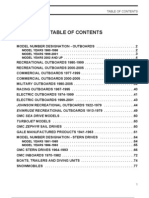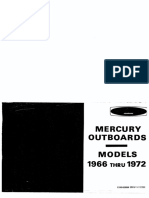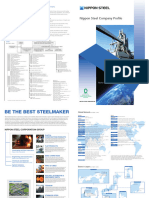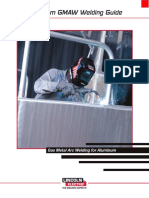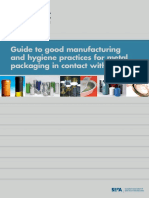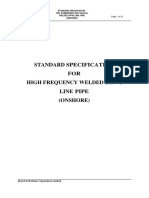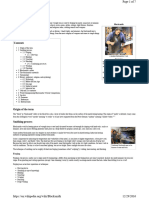1 04P04
1 04P04
Uploaded by
Anonymous zuu1MLCopyright:
Available Formats
1 04P04
1 04P04
Uploaded by
Anonymous zuu1MLOriginal Title
Copyright
Available Formats
Share this document
Did you find this document useful?
Is this content inappropriate?
Copyright:
Available Formats
1 04P04
1 04P04
Uploaded by
Anonymous zuu1MLCopyright:
Available Formats
4
Part 4
Miscellaneous
— 1996 —
FOREWORD
The section on “Specifications for Heat-Treated Carbon Steel Tee Rails (USS CURVEMASTER) as produced by
the United States Steel Corporation” was deleted in its entirety in 1996.
TABLE OF CONTENTS
Section/Article Description Page 1
4.1 Application of Rail Bonds (1995) . . . . . . . . . . . . . . . . . . . . . . . . . . . . . . . . . . . . . . . . . . . . 4-4-2
4.2 General Requirements of a Rail Joint (1961) . . . . . . . . . . . . . . . . . . . . . . . . . . . . . . . . . . 4-4-2
4.3 Purchases of New Rail (1995) . . . . . . . . . . . . . . . . . . . . . . . . . . . . . . . . . . . . . . . . . . . . . . . 4-4-2
3
4.4 Beveling or Slotting of Rail Ends (1995) . . . . . . . . . . . . . . . . . . . . . . . . . . . . . . . . . . . . . . 4-4-3
4.5 Reconditioning Rail Ends (1995) . . . . . . . . . . . . . . . . . . . . . . . . . . . . . . . . . . . . . . . . . . . . 4-4-3
4.6 Illustrations of Shells and Related Gage Corner Developments . . . . . . . . . . . . . . . . . . 4-4-3
4.6.1 Head Check (1970) . . . . . . . . . . . . . . . . . . . . . . . . . . . . . . . . . . . . . . . . . . . . . . . . . . . . . . . . 4-4-3
4.6.2 Flaking (1970) . . . . . . . . . . . . . . . . . . . . . . . . . . . . . . . . . . . . . . . . . . . . . . . . . . . . . . . . . . . . 4-4-3
4.6.3 Shelly Spots (1970) . . . . . . . . . . . . . . . . . . . . . . . . . . . . . . . . . . . . . . . . . . . . . . . . . . . . . . . . 4-4-3
4.7 Specifications for Fully-heat-treated Carbon Steel Tee Rails as Produced by
Bethlehem Steel Corporation . . . . . . . . . . . . . . . . . . . . . . . . . . . . . . . . . . . . . . . . . . . . . . 4-4-5
4.7.1 Scope (1975) . . . . . . . . . . . . . . . . . . . . . . . . . . . . . . . . . . . . . . . . . . . . . . . . . . . . . . . . . . . . . . 4-4-5
4.7.2 Selection of Rails for Treatment (1975) . . . . . . . . . . . . . . . . . . . . . . . . . . . . . . . . . . . . . . . . 4-4-5
4.7.3 Heat Treatment (1975) . . . . . . . . . . . . . . . . . . . . . . . . . . . . . . . . . . . . . . . . . . . . . . . . . . . . . 4-4-5
4.7.4 Finishing (1975). . . . . . . . . . . . . . . . . . . . . . . . . . . . . . . . . . . . . . . . . . . . . . . . . . . . . . . . . . . 4-4-6
4.7.5 Testing (1975) . . . . . . . . . . . . . . . . . . . . . . . . . . . . . . . . . . . . . . . . . . . . . . . . . . . . . . . . . . . . 4-4-6
4.7.6 Brinell Hardness (1975) . . . . . . . . . . . . . . . . . . . . . . . . . . . . . . . . . . . . . . . . . . . . . . . . . . . . 4-4-6
4.7.7 Retreatment (1975) . . . . . . . . . . . . . . . . . . . . . . . . . . . . . . . . . . . . . . . . . . . . . . . . . . . . . . . . 4-4-6
4.7.8 Identification (1975) . . . . . . . . . . . . . . . . . . . . . . . . . . . . . . . . . . . . . . . . . . . . . . . . . . . . . . . 4-4-6
© 1999, American Railway Engineering and Maintenance-of-Way Association 4-4-1
Rail
LIST OF FIGURES
Figure Description Page
4-1 Rail Head Check . . . . . . . . . . . . . . . . . . . . . . . . . . . . . . . . . . . . . . . . . . . . . . . . . . . . . . . . . . . . . . 4-4-4
4-2 Rail Flaking . . . . . . . . . . . . . . . . . . . . . . . . . . . . . . . . . . . . . . . . . . . . . . . . . . . . . . . . . . . . . . . . . . 4-4-4
4-3 Black Spot Shell. . . . . . . . . . . . . . . . . . . . . . . . . . . . . . . . . . . . . . . . . . . . . . . . . . . . . . . . . . . . . . . 4-4-4
4-4 Light Shell . . . . . . . . . . . . . . . . . . . . . . . . . . . . . . . . . . . . . . . . . . . . . . . . . . . . . . . . . . . . . . . . . . . 4-4-4
4-5 Heavy Shell . . . . . . . . . . . . . . . . . . . . . . . . . . . . . . . . . . . . . . . . . . . . . . . . . . . . . . . . . . . . . . . . . . 4-4-5
SECTION 4.1 APPLICATION OF RAIL BONDS1 (1995)
The application of pin connected bonds or welded bonds to the outer side of rail head, within the limits of the
joint bars for standard bonding and outside of joint bars for special work where not practicable to apply them
within the joint bar limits, is good practice.
SECTION 4.2 GENERAL REQUIREMENTS OF A RAIL JOINT2 (1961)
A rail joint should fulfill the following general requirements:
a. It should so connect the rails that they will act as a continuous girder with uniform surface and
alignment.
b. Its resistance to deflection should approach, as nearly as practicable, that of the rail to which it is to be
applied.
c. It should prevent vertical or lateral movement of the ends of the rails relative to each other, and unless
otherwise specified, it should permit longitudinal movement necessary for expansion and contraction.
d. It should be as simple and of as few parts as possible to be effective.
SECTION 4.3 PURCHASES OF NEW RAIL3 (1995)
It is recommended that railroads restrict their purchases of new rail to the following sections:
115 RE 133 RE
119 RE 136 RE (10 head radius)
132 RE 140 RE
1 References, Vol. 28, 1927, pp. 1009, 1354; Vol. 31, 1930, pp. 1458, 1770; Vol. 49, 1948, pp. 375, 614; Vol. 54, 1953, pp. 1178, 1413; Vol. 57,
1956, pp. 786, 1088; Vol. 62, 1961, pp. 590, 952. Reapproved with revisions 1995.
2 References, Vol. 7, 1906, pp. 655, 657; Vol. 16, 1915, pp. 729, 1145; Vol. 38, 1937, pp. 216, 635; Vol. 50, 1949, pp. 484, 795; Vol. 54, 1953,
pp. 1178, 1413; Vol. 62, 1961, pp. 590, 952. Reapproved with revisions 1961.
3 References, Vol. 62, 1961, pp. 592, 952; Vol. 63, 1962, pp. 499, 768; Vol. 87, 1986, p. 84; Vol. 96, p. 29. Reapproved with revisions 1995.
© 1999, American Railway Engineering and Maintenance-of-Way Association
4-4-2 AREMA Manual for Railway Engineering
Miscellaneous
SECTION 4.4 BEVELING OR SLOTTING OF RAIL ENDS1 (1995)
a. Where rail is to be beveled, it is recommended that such beveling extend ¹⁄₁₆ inch back from the end and
to a depth of ¹⁄₈ inch plus, from the surface. (Also refer to current AREMA Plan No. 1005 in Portfolio of
Trackwork Plans.)
b. Rail ends at bonded insulated joints shall not be beveled.
SECTION 4.5 RECONDITIONING RAIL ENDS2 (1995)
Reconditioning of rail ends by welding, grinding or cropping is recommended as good practice.
When slotting at insulated joints, any head overflow shall be removed flush with the rail end. Care should be
taken not to increase the existing gap and to minimize damage to the end post.
SECTION 4.6 ILLUSTRATIONS OF SHELLS AND RELATED GAGE CORNER
DEVELOPMENTS3
— 1960 —
1
4.6.1 HEAD CHECK (1970)
Hair line cracks which appear in the gage corner of the rail head, at any angle with the length of the rail. When
not readily visible the presence of the checks may often be detected by the raspy feeling of their sharp edges see
(Figure 4-1). 3
4.6.2 FLAKING (1970)
Where small shallow flakes of surface metal generally not more than ¹⁄₄ inch in length or width break out of the
gage corner of the rail head (Figure 4-2).
4.6.3 SHELLY SPOTS (1970) 4
a. Where a thin (usually ³⁄₈ inch in depth or less) shell-like piece of surface metal becomes separated from
the parent metal in the rail head, generally at the gage corner. It may be evidenced by:
• a black spot appearing on the rail head over the zone of separation (Figure 4-3);
• a piece of metal breaking out completely, leaving a shallow cavity in the rail head (Figure 4-4 and
Figure 4-5).
b. In the case of a small shell there may be no surface evidence, the existence of the shell being apparent
only after the rail is broken or sectioned.
1 References, Vol. 40, 1939, pp. 597, 739; Vol. 52, 1951, pp. 597, 824; Vol. 54, 1953, pp. 1178, 1413; Vol. 62, 1961, pp. 590, 952; Vol. 96, p. 29.
Reapproved with revisions 1995.
2 References, Vol. 26, 1925, pp. 568, 1404; Vol. 37, 1936, pp. 469, 1013; Vol. 48, 1947, pp. 656, 908; Vol. 54, 1953, pp. 1181, 1414; Vol. 62,
1961, pp. 590, 952; Vol. 96, p. 29. Reapproved with revisions 1995.
3 References, Vol. 61, 1960, pp. 832, 1217. Adopted 1960.
© 1999, American Railway Engineering and Maintenance-of-Way Association
AREMA Manual for Railway Engineering 4-4-3
Rail
Figure 4-1. Rail Head Check
Figure 4-2. Rail Flaking
Figure 4-3. Black Spot Shell
Figure 4-4. Light Shell
© 1999, American Railway Engineering and Maintenance-of-Way Association
4-4-4 AREMA Manual for Railway Engineering
Miscellaneous
Figure 4-5. Heavy Shell
SECTION 4.7 SPECIFICATIONS FOR FULLY-HEAT-TREATED CARBON STEEL TEE1
RAILS AS PRODUCED BY BETHLEHEM STEEL CORPORATION
— 1975 —
4.7.1 SCOPE (1975)
1
These specifications cover fully-heat-treated (oil quenched and tempered) carbon steel tee rails and rail
components for fabricated trackwork, in rail weights of 61 lb per yard and over.
4.7.2 SELECTION OF RAILS FOR TREATMENT (1975)
The rails to be heat-treated shall be selected from heats which have met all the requirements of the latest
3
specifications of the American Railway Engineering Association for steel rails. Only No. 1 rails shall be selected;
“A” rails and No. 2 rails shall be eliminated.
4.7.3 HEAT TREATMENT (1975)
4.7.3.1 Quenching
4
The rails selected for heat-treatment shall be heated to the proper temperature and held for a sufficient time to
effect the desired transformation in the steel throughout the full cross-section and length. The tails shall then
be removed from the heating furnace and quenched (fully immersed) in an oil bath under substantially uniform
conditions. Each group thus treated shall be termed a quenching charge.
4.7.3.2 Tempering
Upon completion of the quenching operations, the rails shall be removed from the oil bath, charged into the
tempering furnace and reheated gradually and evenly to the proper temperature and shall be held at that
temperature a sufficient length of time to relieve the stresses and bring into proper balance the mechanical
properties of the steel. The rail shall then be cooled under controlled conditions. Each group thus treated shall
be termed a tempering charge.
1 References, Vol. 75, 1974, p. 484. Adopted 1975.
© 1999, American Railway Engineering and Maintenance-of-Way Association
AREMA Manual for Railway Engineering 4-4-5
Rail
4.7.4 FINISHING (1975)
The treated rails shall be straightened, carefully inspected and loaded for shipment or prepared for fabrication.
4.7.5 TESTING (1975)
4.7.5.1 Sampling
A piece of rail at least 6 inches long representing the rails involved shall be processed with each quenching and
tempering charge for use as a test sample.
4.7.5.2 Testing Procedure
The Brinell hardness test performed on the test sample shall be made on the top of the rail head. Before making
the impression, any decarburized metal shall be removed from the top of the rail head at the point selected, and
the surface of the rail head at that point shall be properly prepared to permit an accurate determination of
hardness. The results of such tests shall conform to the requirements of Paragraph 4.7.6.
4.7.6 BRINELL HARDNESS (1975)
Carbon steel rails and rail components for fabricated trackwork when fully-heat-treated (oil-quenched and
tempered) and tested in accordance with Paragraph 4.7.5.1 and Paragraph 4.7.5.2 shall show equivalent Brinell
hardness values as follows:
Nominal Weight Per Yard 61-80 81-90 91 and over
Brinell Hardness Number 277-341 293-363 321-388
Upon request, results of the Brinell hardness tests shall be supplied to the purchaser or his representative.
4.7.7 RETREATMENT (1975)
Any heat-treated rails failing to meet the above Brinell hardness requirements may be retreated, at the option
of the manufacturer, and such retreated rails shall be retested in accordance with Paragraph 4.7.5.1 and
Paragraph 4.7.5.2.
4.7.8 IDENTIFICATION (1975)
a. All heat-treated rails shall be marked with the letter “T.”
b. At the option of the manufacturer:
• The letters “CT” may be hot-stamped into the web of rails to be heat-treated, the letter “T,” to be
properly ground off the web of any rail which is not subsequently heat-treated;
• or the letter “T” may be cold stamped on each of the two end faces of each heat-treated rail.
c. All heat-treated rails shall be paint-marked orange on the head and in the web at or near each end of
each rail.
© 1999, American Railway Engineering and Maintenance-of-Way Association
4-4-6 AREMA Manual for Railway Engineering
You might also like
- Mercury Outboards Models 1966 Thru 1972 Service Manual (PDF, ENG, 2.16 MB) PDFDocument43 pagesMercury Outboards Models 1966 Thru 1972 Service Manual (PDF, ENG, 2.16 MB) PDFbilly_gfroerer50% (2)
- 307.1074.3.5 (En) Air Cooled Engine Serie 1000Document172 pages307.1074.3.5 (En) Air Cooled Engine Serie 1000Lacatusu Mircea100% (2)
- AREMA MRE Chapter 4 2017 PDFDocument2 pagesAREMA MRE Chapter 4 2017 PDFAman 'kebe' Kebede0% (3)
- Motor 2.7 V6 JourneyDocument196 pagesMotor 2.7 V6 JourneyLeandro FerreiraNo ratings yet
- Mil STD 40007Document19 pagesMil STD 40007engine100% (3)
- Evinrude Johnson Gale ID ChartDocument80 pagesEvinrude Johnson Gale ID ChartMichaelNo ratings yet
- Fig 1 Some of The Ladle Metallurgy ProcessesDocument4 pagesFig 1 Some of The Ladle Metallurgy ProcessesNikesh KoliNo ratings yet
- BS 806 Boiler PipingDocument153 pagesBS 806 Boiler PipingAmrit Pal Singh100% (1)
- Arema Capitulo 4Document2 pagesArema Capitulo 4edisjdav60% (5)
- AREMA Cap. 4Document2 pagesAREMA Cap. 4reynaldoUH0% (1)
- Arema Mre 2013 Toc-Vol1 Ch5Document3 pagesArema Mre 2013 Toc-Vol1 Ch5Ndoro Bei0% (3)
- Arema Mre 2015 Toc-Vol1 Ch4Document2 pagesArema Mre 2015 Toc-Vol1 Ch4Adnan Hariadi Bustami0% (2)
- 1 04CH4Document2 pages1 04CH4HARINo ratings yet
- Hydrofoil ErrDocument247 pagesHydrofoil ErrDivine Digital DesignNo ratings yet
- Design of Rail - 2019 - : Section/Article DescriptionDocument8 pagesDesign of Rail - 2019 - : Section/Article DescriptionHARINo ratings yet
- Propeller Theories Kerwin - Notes PDFDocument234 pagesPropeller Theories Kerwin - Notes PDFSaeed JavdaniNo ratings yet
- AREMA CHAPTER 1 - Section 4.9 Corrugated Polypropylene Pipe - Approval Januray 2016Document15 pagesAREMA CHAPTER 1 - Section 4.9 Corrugated Polypropylene Pipe - Approval Januray 2016pquiroga2No ratings yet
- 66 72 PDFDocument43 pages66 72 PDFrydenNo ratings yet
- Ch0 c1fm5125 Rigging Techniques Procedures and ApplicationsDocument18 pagesCh0 c1fm5125 Rigging Techniques Procedures and ApplicationslambertNo ratings yet
- FM-5-125 Rigging Techniques, Procedures, and ApplicationsDocument169 pagesFM-5-125 Rigging Techniques, Procedures, and ApplicationsStodgyAyatollah100% (2)
- DIN 4014 Bored PilesDocument14 pagesDIN 4014 Bored Pilesgianno1985No ratings yet
- ABS RULES TOWING CAPTER 5 SMR - Part - 5 - E-July10 PDFDocument125 pagesABS RULES TOWING CAPTER 5 SMR - Part - 5 - E-July10 PDFventa kevaraNo ratings yet
- FLUENT 12.0 Theory GuideDocument816 pagesFLUENT 12.0 Theory GuideMark CampbellNo ratings yet
- Ansys Fluent 12.0 Theory GuideDocument816 pagesAnsys Fluent 12.0 Theory GuidetobeloyaltyNo ratings yet
- Pile Foundations - 1994 - : 8www - NBMDocument20 pagesPile Foundations - 1994 - : 8www - NBMMarwan MokhadderNo ratings yet
- 1 01P07Document4 pages1 01P07AntozepNo ratings yet
- Roadway Signs - 1996 - : Section/Article DescriptionDocument4 pagesRoadway Signs - 1996 - : Section/Article DescriptionHARINo ratings yet
- Turbine RepairDocument67 pagesTurbine RepairFrancisco Novoa Rodriguez50% (2)
- Fundamentals of Machine Design 3, Orlov PDFDocument272 pagesFundamentals of Machine Design 3, Orlov PDFarcelitas93% (14)
- Slipso400 ManualDocument24 pagesSlipso400 Manualwjaniak_1No ratings yet
- Lab Report 09Document11 pagesLab Report 09uc3615160No ratings yet
- Section 4 - Driveline-AxleDocument171 pagesSection 4 - Driveline-AxleMTK2016No ratings yet
- Soil Stabilization Pavements PDFDocument57 pagesSoil Stabilization Pavements PDFabhinav7373No ratings yet
- Ese 00779 enDocument42 pagesEse 00779 enAnderson CampiolNo ratings yet
- Fluent Theory ManualDocument816 pagesFluent Theory Manualkarthik_deven100% (2)
- Hold the Westwall: The History of Panzer Brigade 105, September 1944From EverandHold the Westwall: The History of Panzer Brigade 105, September 1944Rating: 5 out of 5 stars5/5 (2)
- The Complete Anchoring Handbook: Stay Put on Any Bottom in Any WeatherFrom EverandThe Complete Anchoring Handbook: Stay Put on Any Bottom in Any WeatherRating: 3 out of 5 stars3/5 (1)
- The Rise and Fall of a Muslim Regiment: The Manṣūriyya in the First Mamluk Sultanate, 678/1279–741/1341From EverandThe Rise and Fall of a Muslim Regiment: The Manṣūriyya in the First Mamluk Sultanate, 678/1279–741/1341No ratings yet
- Knots, Bends, Splices With tables of strengths of ropes, etc. and wire riggingFrom EverandKnots, Bends, Splices With tables of strengths of ropes, etc. and wire riggingNo ratings yet
- The book of the Volkswagen Type 3: Concept, Design, International Production Models & DevelopmentFrom EverandThe book of the Volkswagen Type 3: Concept, Design, International Production Models & DevelopmentNo ratings yet
- Time Counts: Quantitative Analysis for Historical Social ScienceFrom EverandTime Counts: Quantitative Analysis for Historical Social ScienceNo ratings yet
- Physical Principles of Medical UltrasonicsFrom EverandPhysical Principles of Medical UltrasonicsC. R. HillNo ratings yet
- The Fly Tying Artist: Creative Patterns for Common HatchesFrom EverandThe Fly Tying Artist: Creative Patterns for Common HatchesRating: 5 out of 5 stars5/5 (1)
- The Boatbuilder's Apprentice (PB): The Ins and Outs of Building Lapstrake, Carvel, Stitch-and-Glue, Strip-Planked, and Other Wooden BoaFrom EverandThe Boatbuilder's Apprentice (PB): The Ins and Outs of Building Lapstrake, Carvel, Stitch-and-Glue, Strip-Planked, and Other Wooden BoaRating: 4 out of 5 stars4/5 (2)
- Nipponsteel Brochure enDocument2 pagesNipponsteel Brochure envenkateshNo ratings yet
- FENN Division Tcm20-23390Document15 pagesFENN Division Tcm20-23390Juan Fernando Campuzano100% (1)
- 02.civil - Open Elective SyllabusDocument20 pages02.civil - Open Elective SyllabusChockalingamNo ratings yet
- Welding Defect: Hydrogen EmbrittlementDocument8 pagesWelding Defect: Hydrogen EmbrittlementShajin Mohammed ShamsudhinNo ratings yet
- C8.100 Aluminum Welding GuideDocument32 pagesC8.100 Aluminum Welding GuideIvan UriasNo ratings yet
- Manufacturing Hygiene PracticesDocument56 pagesManufacturing Hygiene Practicesmohamed sabry100% (1)
- Tool Steel Hot Forming Heat TreatmentDocument28 pagesTool Steel Hot Forming Heat TreatmenttalalNo ratings yet
- A732A732MDocument6 pagesA732A732MAnderson TadeuNo ratings yet
- Copper & Its AlloysDocument16 pagesCopper & Its AlloysNataliyaNo ratings yet
- Techforum e 12 2004Document90 pagesTechforum e 12 2004damnkaushikNo ratings yet
- Welding & Cutting ProcessDocument16 pagesWelding & Cutting ProcesscvNo ratings yet
- Mumetal Permimphy Supermimphy EngDocument10 pagesMumetal Permimphy Supermimphy Engvsraju2No ratings yet
- Radiography Sai KripaDocument4 pagesRadiography Sai KripaSarthak EnterprisesNo ratings yet
- 1415sem1 Ce2155Document7 pages1415sem1 Ce2155calchan79No ratings yet
- Harting HANDocument180 pagesHarting HANKarlo BrzicaNo ratings yet
- MaterialsDocument30 pagesMaterialshorascanmanNo ratings yet
- Steel Making Fundamentals and ApplicationsDocument212 pagesSteel Making Fundamentals and Applicationsernestaugustus5167100% (4)
- A.K. AUTOMATIC LTD, ROHTAKDocument39 pagesA.K. AUTOMATIC LTD, ROHTAKTinku BudhwarNo ratings yet
- Product Innovation ManagementDocument10 pagesProduct Innovation ManagementProf R K GuptaNo ratings yet
- Standard Specification FOR High Frequency Welded (HFW) Line Pipe (Onshore)Document31 pagesStandard Specification FOR High Frequency Welded (HFW) Line Pipe (Onshore)Agniva DuttaNo ratings yet
- Welding ParametersDocument34 pagesWelding ParametersmilindNo ratings yet
- Macsteel VRN VRN 200 DatasheetDocument1 pageMacsteel VRN VRN 200 DatasheetIgor NhamanoNo ratings yet
- 4-7ts - General Welding Requierments - KBRDocument11 pages4-7ts - General Welding Requierments - KBRKunal SrivastavaNo ratings yet
- Terex Jaques - ST JawDocument12 pagesTerex Jaques - ST Jawjonathandyson100% (2)
- Blacksmith 2016Document7 pagesBlacksmith 2016borisvdpNo ratings yet
- Tenova DRI Hot Feeding SystemDocument1 pageTenova DRI Hot Feeding Systemttr_1983No ratings yet
- SASO Board134Document265 pagesSASO Board134CHERIF100% (1)
- DS-CS-08 - Steel Buildings Rev 0Document12 pagesDS-CS-08 - Steel Buildings Rev 0pigfly2012No ratings yet





